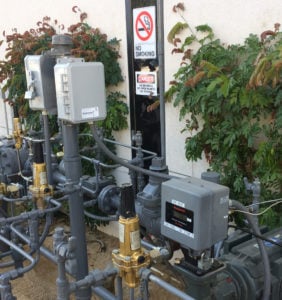Most gas meters are residential, but gas utilities will attest to the fact that commercial customers account for the lion’s share of the profits collected by the utility. When it comes to AMI, these customers require current, accurate, and granular data that can be accessed easily.
So even though advanced metering infrastructure (AMI) networks often are justified as a way to collect meter reads from residential customers for billing, today’s gas utilities can leverage AMI networks to access the additional data they need to serve commercial and industrial (C&I) customers better. For an additional look at how AMI data benefits gas utilities, read this article.
Data requirements for C&I differ
The typical residential meter-reading network provides hourly meter reads across the entire system four times a day. In Aclara networks, the hourly reads are picked up by multiple data collectors, providing a level of redundancy that ensures the utility ends up with at least 24 readings each day for every gas meter.
However, utilities require even more data from C&I meters in order to serve commercial customers. Therefore, residential meter settings don’t apply to C&I meters.
High volume C&I users are billed differently than residential customers. These customers have two or three large gas lines servicing them and their usage is measured by the number of basic thermal units (BTUs) that they use.
To calculate BTU usage, the utility needs both pressure and temperature data. So, commercial meters must provide this data, so that that the corrected amount of BTU’s delivered is calculated and reflected on C&I customers’ bills. The corrected BTU data along with the uncorrected data from C&I gas meters is easily reported to the headend over the same AMI network that the residential meters communicate over.
Additional benefits for C&I
Existing AMI networks can also accommodate data from devices other than meters. Sensors that perform critical functions such as methane detection, pressure monitoring, cathodic protection, and valve monitoring and control are easily incorporated on the existing AMI network.

Transceivers in the gray boxes on the pole are capturing readings from an electronic device measuring corrected and uncorrected volume, temperature, and pressure.
The ability of AMI networks to accommodate sensors helps utilities take advantage of these devices, many of which have become less expensive recently. For example, methane detection sensors are now more cost-effective, making it feasible for utilities to put more sensors across their networks.
The widespread use of methane detectors will make early detection of potential catastrophic leaks possible without relying on the public to report the smell of a gas leak. By having a network of sensors strategically placed around gas pipelines, storage facilities, or other high consequence areas, the utility and the public can enjoy a heightened sense of safety.
Sensors and other critical devices can utilize the same RF channels as the rest of the system or can have their own frequency to allow for high priority messaging. Utilizing either method will provide the utility a reliable communications path. However, when devices can broadcast on multiple frequencies, critical sensors can utilize lower traffic bands.
Device monitoring
A new transceiver from Aclara collects up to ten different pieces of data collected at the meter or device. Along with all this data, the new transceiver will monitor gas pressure and if the preset thresholds are exceeded, an alarm is triggered, and the unit enters a mode of operation (called trend mode) that provides more granular data to help diagnose the issue.
Under default settings, when in trend mode the unit takes a pressure reading every minute and transmits every six minutes. The transceiver continues in this mode until the alarm is cleared or trend mode is terminated from the headend. It is also possible to activate trend mode via a headend command.
To learn how AMI can work in your gas utility, sign up for a free consultation with one of our experts.

